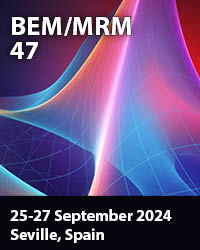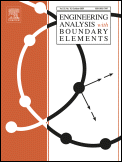32nd International Conference on Boundary Elements and Other Mesh Reduction Methods
7 - 9 September 2010
New Forest, UK
Overview
The 32nd International Conference on Boundary Elements and other Mesh Reduction Methods (BEM/MRM) has recently been held at the Wessex Institute of Technology campus in the New Forest, UK.
The conference was opened by Carlos A Brebbia, Director of the Wessex Institute of Technology, who described the work of the Institute and in particular the research and other activities related to boundary elements.
Looking back to 1978 when the first of these conferences took place, it is rewarding to see – Professor Brebbia said – how far the Boundary Element Method (BEM) has developed in the last three decades (or to be precise 33 years if one dates the beginning from the dates when the first papers in BEM were published, i.e. Brebbia, C.A. and Dominguez, J. ‘The Boundary Element Method for potential problems’ Applied Mathematical Modelling, 1, 372-8, (1977).
What is also remarkable is that the method has now originated a series of ‘derivatives’ dealing with mesh reduction techniques. It was indeed the quest for mesh reduction - Professor Brebbia explained – that was the motivation for the development of the BEM. The fact that BEM was based on boundary integral equations was driven by emerging needs rather than by the understated mathematical beauty and elegance of these equations.
Given the continuous emergence of new techniques, it is important nowadays to bear these concepts in mind, focusing on the user’s needs rather than the interests of the developers. For a new method to be truly successful – Professor Brebbia stated – it must perform well in engineering terms. Analysis techniques which are not reliable and robust are bound to fail, regardless of their high accuracy and excellent performance in a research environment.
Another important quality that any new computational technique needs to offer industrial users is ease of application. Nowadays this includes good interfacing with existing modelling systems.
Professor Brebbia thinks that it is now a good time for looking at a new generation of mesh-reduction methods, based on the substantial amount of work carried out in the last few years. The Proceedings of these BEM conferences, which encourage the presentation of novel ideas, may hold the key to the future of engineering analysis.
Invited Presentations
The conference sessions included a series of outstanding invited presentations by well-known colleagues in the BEM/MRM research field. They were;
‘Simulation of flow of nanofluids by BEM’
by J Ravnik, University of Maribor, Slovenia
'Boundary element solution of thermal creeping flow in a nano single mixer’
by H Power, University of Nottingham, UK
‘Meshless computation for partial differential equations of fractional order’
by Y C Hon, City University of Hong Kong
‘Numerical criteria for calculating the density diffusion in a water reservoir’
by M Kanoh, Kyushu Sangyo University, Japan
‘Compact support size selection in the Radial Basis Integral Equation Method’
by V Popov, Wessex Institute of Technology, UK
‘3-D acoustic shape sensitivity analysis using the fast multipole boundary element method’
by T Matsumoto, Nagoya University, Japan
‘Solution of velocity-vorticity URANS by BEM’
by L Skerget, University of Maribor, Slovenia
‘Efficient regular perturbation solutions for beams subjected to thermal imperfections: a case study’
by B W Yeigh, SUNY Institute of Technology, USA
‘Boundary element modelling of complex grounding systems: study on current distribution’
by D Poljak, University of Split, Croatia
‘Integral equations for crack systems in a slightly heterogeneous elastic medium’
by A N Galybin, Wessex Institute of Technology, UK
‘A new generalized meshless method technique for tracheobronchial airflow modelling’
by E Divo, University of Central Florida, USA
‘A novel boundary meshfree technique: singular boundary method’
by W Chen, Hokai University, China
Conference Sessions
All other papers were grouped into the following sessions;
- Fluid flow
- Advanced formulations
- Computational techniques
- Electrical engineering and electromagnetics
- Dynamics and vibrations
- Damage mechanics and fracture
- Advanced meshless and mesh reduction methods
The conference was characterised by its friendly atmosphere. There was ample time for discussions and the delegates had many occasions for informal talk.
International Journal of Engineering Analysis with Boundary Elements
The Editorial Board of the International Journal of Engineering Analysis with Boundary Elements (EABE) met during one of the evenings for a general discussion over dinner. The meal took place in a renown New Forest restaurant and was accompanied by excellent Italian wines with dishes prepared by a well-known chef. The discussions during and after dinner related to performance of the EABE Journal, which has been excellent, with its Impact Factor having increased by 50% in just one year. The volume of papers reviewed by the editors as well as the quality continues to increase.
The rapid expansion of digital media has resulted in a wider dissemination of the Journal around the world. Professor Brebbia gave a short introduction explaining the strategy of Elsevier and their plan for the future of Journal publishing. The importance of continuing to promote the Journal was stressed and in particular the need to arrange for a few more special issues. The evening finished with a general discussion which resulted in a list of requests and suggestions for Elsevier.
Excursions and social events
A barbeque was arranged for lunch on the first day which provided an ideal occasion for the delegates to get to know each other better. The food – roasted lamb – was cooked to perfection and the good weather made this a unique occasion.
A special excursion was organised to the historic city of Winchester, capital of the kingdom of Wessex and later of England, before the crown moved to London. The city is renown throughout the world for its famous cathedral which was built by the first Norman of England (William the Conqueror) 1,000 years ago, around the time that the New Forest originated. There they were given a guided tour, pointing out some of the architectural details which included parts built in the Romanesque and Gothic styles. The cathedral was the church where Felipe II of Spain married Mary Tudor, a union which could have cemented the friendship of the two nations but for the unfortunate death of Mary who passed away without children. Many historical figures are buried there, including the writer Jane Austen. After seeing the cathedral, the delegates had time to visit the centre of Winchester and some of them went to see the famous Round Table of King Arthur’s knights, until recently a law court.
The conference banquet took place in a renown hotel in the New Forest. This is located in Park Hill House, a historical site that for a long time belonged to the consort of the King of England and much later became a very exclusive school. It was only in the last 50 or so years that the place was made into a hotel which is now one of the best in the South of England after having undergone extensive renovation. It is well-known for the standard of its cuisine and the excellent service it provides. Professor Brebbia thanked the delegates for having attended the banquet and explained the history of the original building.
The conference was highly successful and helped to cement the links between the participants, all members of the international BEM community. It will be reconvened from 28-30 June 2011 at the WIT campus in the New Forest.
Publication of Papers
The proceedings of Boundary Elements and Other Mesh Reduction Methods XXXII, 336pp (Print ISBN: 978-1-84564-470-3; Online ISSN: 1743-355X) are available from WIT Press priced at £128/US$256/€179. Orders can be placed online at www.witpress.com or by email:
Papers from the conference will also be hosted online in the WIT eLibrary as Volume 50 of WIT Transactions on Modelling and Simulation (ISSN: 1743-355X). For more details visit the WIT eLibrary at http://library.witpress.com




